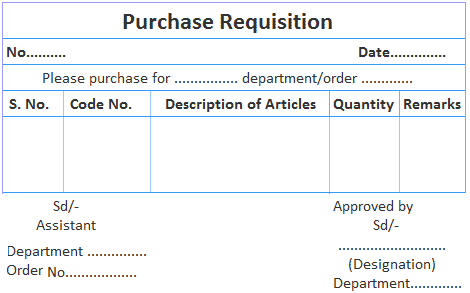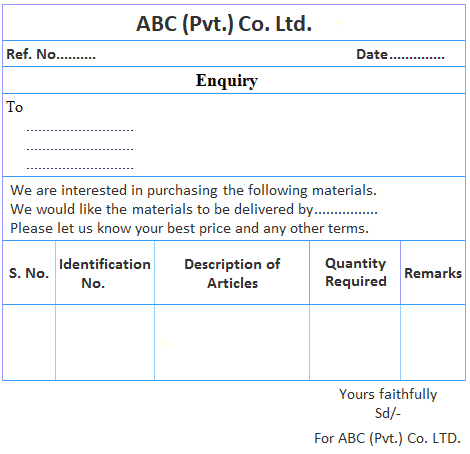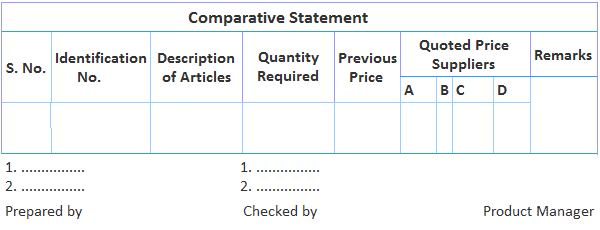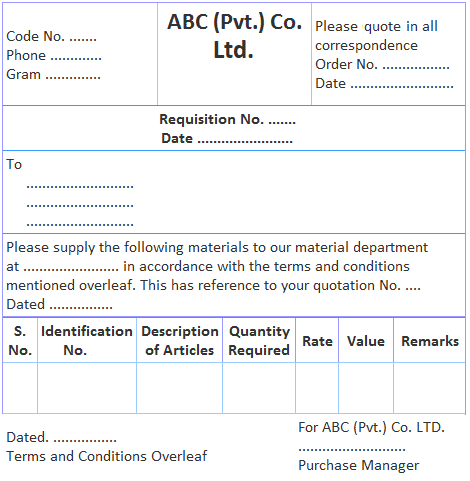Purchasing of Material- Simplified
What Is Meant by the Purchasing of Materials?
Purchasing of materials refers to the procurement of materials for a price. It is usually handled by a specific department (e.g., purchase manager in the procurement department), particularly in large companies.
A purchasing department can function effectively if:
- It is organized on a centralized basis
- Full co-operation between purchasing department and other departments is assured
- A close relationship exists between the purchasing department and the accounts department
- The purchase manager is technically qualified and sufficiently experienced
- A proper procedure is clearly set out and strictly adhered to
Purchasing is a critically important and specialized activity in manufacturing companies. Materials account for a considerable portion of production costs. As such, the purchase manager in such a business is responsible for spending more of its money than anyone else.
Any errors on the part of the purchase manager, therefore, may be extremely expensive. Furthermore, purchasing sub-standard materials will undermine product quality, cause wastage, and lead to costly machine breakdowns.
Hence, it is fundamentally important to ensure that the function of purchasing materials is performed effectively, efficiently, and economically.
According to Alford and Beatty, “purchasing is the procuring of materials, supplies, machines, tools, and services required for the equipment, maintenance, and operation of a manufacturing plant.”
As noted above, the purchasing function is typically performed by a separate purchasing department set up under an expert buyer (or purchase manager). To carry out their duties effectively, the purchase manager must know:
- What to purchase
- When to purchase
- Where to purchase
- How much to purchase
- At what price to purchase
What to Purchase
Normally, some of the spare parts and components that a manufacturing concern requires are manufactured in the company itself rather than being purchased externally. The various items of stores that the purchasing department should procure are:
- All the items of materials, stores, spares, and components that the manufacturing concern cannot make
- Other items that the manufacturing concern can make but does not want to make
Decision-making in respect of the items falling under the second category is an important function of the purchasing department. The decision about whether to buy or produce a particular item depends on factors such as:
- Annual requirements for the item
- Purchase frequency for the item
- Availability of spare manufacturing capacity to produce the item
- The price advantage arising out of the comparative cost of making and buying
- Product secrecy
The decision to give preference to buying is of the utmost importance. Such decisions are made by the purchasing department under the guidance of the planning department and cost department.
When to Purchase
Materials are generally purchased as and when requisitions are received from the stores department. If certain items are only available during a particular season, purchases are made during the season.
For items restricted by government regulations, the question of when to purchase will be determined with reference to the date of the license, quota, or permit, as the case may be.
Where to Purchase
The purchasing department generally maintains a list of approved suppliers for various items of materials. Whenever materials are required, purchases are made from these suppliers after receiving their quotes.
If there are long-term requirements to purchase materials on a regular basis in bulk, the materials are purchased from specific suppliers only. In the case of controlled materials, purchases are also only made from specific suppliers.
How Much to Purchase
The quantity of materials to be purchased is another important criterion for decision-making. The purchase department is guided in this respect by the purchase requisition received from the stores department.
However, in organizations that use the budgetary control technique, the purchase budget that is prepared and approved in advance shows the timings and quantity of purchases. Thus, in such cases, the approved budget is the guiding factor.
Some manufacturing concerns adopt the control technique of economic order quantity (EOQ), which indicates the quantity and frequency of purchases. EOQ ensures that the costs involved in purchasing materials and carrying inventory are minimized.
At What Price to Purchase
The price to be paid is a key factor that influences the cost of materials. In case tenders or quotations have been invited and received, it is the responsibility of the purchasing department to select the price at which the materials should be purchased.
Normally, in this case, the tender or quotation that offers the lowest price is selected. However, the terms of delivery, credit period allowed, rate of discount, and the reliability and capacity of the supplier to execute orders should also be considered.
If materials are supplied through a controlling authority, the purchase manager has no option but to procure the supply at the price fixed by the authority.
Types of Purchasing
Purchasing of materials can be undertaken on a centralized or decentralized basis. In either case, it is important to keep in view the nature, size, and requirements of the business.
Centralized Purchasing
Under centralized purchasing, the authority to purchase materials for all the departments in an organization is placed on one individual or one department (e.g., the purchasing department headed by a purchase manager).
Advantages of Centralized Purchasing
The main advantages of centralized purchasing are as follows:
- A uniform and firm policy can be pursued with regard to the conditions of purchasing (e.g., terms of payment).
- Purchasing of materials is the sole responsibility of the purchasing department, meaning that other departments can concentrate on production.
- Since the materials are purchased in larger quantities, it is possible to benefit from better rates from suppliers.
- Different items of material can be standardized.
- The buying staff, by concentrating on purchasing alone, develop specialized knowledge and skills, leading to expertise and, in turn, economical buying.
- Centralized purchasing facilitates the maintenance of one complete set of records for purchase transactions, enabling management to exercise better control over purchases.
- Centralized purchasing helps to coordinate purchasing activities and, by placing authority for purchasing on one person, avoids duplication and overlap.
- Centralized purchasing helps to control inventories and avoid excessive investment in materials.
Disadvantages of Centralized Purchasing
Centralized purchasing also has several well-defined limitations, including:
- The procedure used to purchase materials is not flexible, which may lead to delays in obtaining supplies.
- Setting up a separate purchasing department leads to high administration costs.
Decentralized Purchasing
Under decentralized purchasing (also known as localized purchasing), the authority to purchase materials is placed in the hands of more than one individual or department. Under this system, each departmental head makes purchases for their own department.
Advantages of Decentralized Purchasing
Decentralized purchasing is beneficial for the following reasons:
- It enables flexibility in the purchase routine, thereby helping to avoid procurement delays.
- Under decentralized purchasing, no specialized buying team is appointed, which reduces administration costs.
- Decentralized purchasing is more efficient than centralized purchasing because each departmental head can assess their department’s requirements and problems most effectively.
Disadvantages of Decentralized Purchasing
Decentralized purchasing also suffers from the following disadvantages:
- Decentralized purchasing is not economical because materials are purchased in smaller lots (as such, volume discounts or favorable purchase terms cannot be obtained).
- Lacks a uniform policy for the purchasing of materials.
- Different prices may be paid for the same materials by different departments.
- Expert buying staff cannot be engaged for each department of the organization.
- There is no coordination among departments, which can lead to duplication and overlap.
- The heads of various operating departments, in being responsible for purchasing materials, cannot concentrate fully on their routine duties.
Purchasing Procedure or Purchasing Cycle
1. Initiation of Purchase
This starts with the receipt of a purchase requisition by the purchasing department. The purchase requisition is prepared by the storekeeper based on:
- Requisitions received from the departments of the enterprise
- Replenishment policy being pursued
- Special requisitions for specific equipment and materials
- Personal judgment and experience (if permitted)
The requisitions are usually approved by staff who are authorized to grant approval. The storekeeper ensures that they are acting according to standard policies. They prepare the purchase requisitions in triplicate.
The first one (i.e., the original) is sent to the purchasing department, the next one is sent to the cost department, and the last one is retained by the stores department.
More copies may be prepared depending on the requirements of the enterprise.
The purchase requisition forms the basis of the order to be placed with suppliers. Therefore, this should be prepared with careful attention. This helps to purchase the right quantity of materials at the right quality, the right place, from the right source, and at the right time.
This helps the enterprise to procure materials at a competitive price. It also helps to ensure the smooth and uninterrupted operations of the enterprise.
Format/Specimen of Purchase Requisition

2. Inviting Quotations
After the receipt of the purchase requisition, the purchase department would proceed further and invite quotations, etc. from suppliers. The usual practice is to send an inquiry proforma to the supplier. The specimen of the Enquiry Proforma is given below :
3. Receipt of Supplier’s Quotation
The supplier, after receiving the inquiry letter, provides a quote and states the terms and conditions of the supply of materials to the purchasing department. The supplier also provides quality, quantity, time of delivery, price, discount, and other necessary information.
This submission is important from the point of view of both the purchaser and the supplier. It is an offer in legal terms. This, therefore, requires careful handling and proper preservation.
4. Preparation of Comparative Statement
The comparative statement (or a comparative schedule of quotations) is prepared after the quotes are received from the supplier.
It is prepared with a view to comparing the prices, terms, and conditions, and it helps in selecting the supplier whose terms are most favorable to the organization.
The comparative statement is an important document that should be carefully kept on record for future reference and guidance. The prepared statement is submitted to the head of the purchasing department for approval.
The purpose of preparing a comparative statement is to realize the money’s worth. A proforma of a comparative statement is given below.
5. Preparation and Placement of Purchase Order
The last action involved in purchasing materials is to prepare and place a purchase order. A purchase order is a legal document that implies the acceptance of the supplier’s offer.
The purchase order should, therefore, be prepared with great care and in complete detail. This helps the supplier to ensure that they will supply materials of the right quality, the right quantity, and at the right time.
Purchase orders are orders to the supplier to supply the required materials as per their quotations and the instructions contained therein. A proforma of the purchase order is given as follows:
Generally, the purchase order is prepared in triplicate. The original copy is dispatched to the supplier, the duplicate is sent to the account section, and the triplicate is retained for future reference.
However, if more copies are required, these should also be prepared. For example, if five copies are to be prepared, the fourth one could be sent to storekeeping and the fifth one could be sent to the requisitioning department.

A business credit report details everything you need to know about your finances. It includes your payment history, credit history, tax liens, etc. If you can maintain a good company credit report in India, you’re likely to enjoy benefits like a good rapport among clients, positive reviews about your business, etc. You can check your business credit report on any leading credit information platform like CreditQ. You can also report your defaulters on CreditQ, and we will help you recover your money.
ReplyDelete